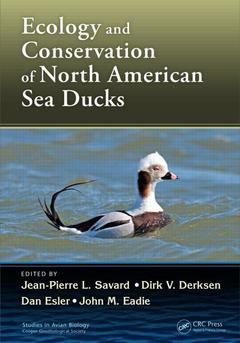Ecology and Conservation of North American Sea Ducks Studies in Avian Biology Series
Coordonnateurs : Savard Jean-Pierre L., Derksen Dirk V., Esler Dan, Eadie John M.

The past decade has seen a huge increase in the interest and attention directed toward sea ducks, the Mergini tribe. This has been inspired, in large part, by the conservation concerns associated with numerical declines in several sea duck species and populations, as well as a growing appreciation for their interesting ecological attributes. Reflecting the considerable research recently conducted on this tribe, Ecology and Conservation of North American Sea Ducks examines the 15 extant species of sea ducks from North America.
Chapters are organized conceptually to focus on, compare, and contrast the ecological attributes of the tribe. Experts provide in-depth treatments of a range of topics, including:
- Population dynamics and genetics
- Infectious diseases and parasites
- Breeding costs and cross-seasonal affects
- Contaminant burdens
- Foraging behavior and energetics
- Migration strategies, molt ecology, and habitat affinities and dynamics
- Breeding systems and reproductive behavior
- Harvest history
Published in collaboration with and on behalf of the American Ornithological Society, this volume in the highly-regarded Studies in Avian Biology series presents a comprehensive synthesis of sea duck ecology, documents factors that have caused population declines of some species, and provides managers with measures to enhance recovery of depressed populations of sea ducks in North America. Capturing the current state of knowledge of this unique tribe, it provides a benchmark for where we are in conservation efforts and suggests future directions for researchers, managers, students, conservationists, and avian enthusiasts.
Key Selling Features:
- Provides the first comprehensive assessment of the status, population dynamics, and demography of sea ducks across North America
- Characterizes phylogeography, phylogenetics, and population genetics
- Examines the diseases, parasites, biological toxins, and contaminants affecting sea ducks
- Provides an up-to-date assessment of migration and molt strategies
- Documents reproductive energetics, strategies, and behavior
Status and Trends of North American Sea Ducks: Reinforcing the Need for Better Monitoring. Phylogenetics, Phylogeography, and Population Genetics of North American Sea Ducks (Tribe: Mergini). Population Dynamics of Sea Ducks: Using Models to Understand the Causes, Consequences, Evolution, and Management of Variation in Life History Characteristics. Infectious Diseases, Parasites, and Biological Toxins in Sea Ducks. Dealing with Deficits: Breeding Costs, Nutrient Reserves, and Cross-Seasonal Effects in Sea Ducks. Metals and Trace Elements, Petroleum, Organic Pollutants, and Radiation in Sea Ducks. Foraging Behavior, Ecology, and Energetics of Sea Ducks. Variation in Migration Strategies of North American Sea Ducks. Remigial Molt of Sea Ducks. Site Fidelity, Breeding Habitats, and the Reproductive Strategies of Sea Ducks. Breeding Systems, Spacing Behavior, and Reproductive Behavior of Sea Ducks. Harvest of Sea Ducks in North America: A Contemporary Summary. Habitats of North American Sea Ducks. Conservation of North American Sea Ducks. Conclusions, Synthesis, and Future Directions: Understanding Sources of Population Change. Appendix A: North American Sea Ducks. Index.
Jean-Pierre L. Savard is a scientist emeritus with Environment Canada, Quebec, Canada. Dr. Savard earned his PhD from the University of British Columbia, where he conducted research on the territorial behavior, nesting success, and brood survival of Barrow’s Goldeneye, Common Goldeneye, and Bufflehead Ducks. He has published numerous papers focused on the biology and population dynamics of sea ducks including Common Eider, Harlequin Duck, Surf Scoter, Black Scoter, Long-Tailed Duck, Bufflehead, Barrow’s Goldeneye, Common Goldeneye, Hooded Merganser, and Red-Breasted Merganser.
Dirk V. Derksen is retired from the U.S. Geological Survey, Alaska Science Center, Anchorage, Alaska, where he served as chief of migratory bird, terrestrial mammal, and genetics research over a 26-year period. Dr. Derksen earned his PhD from Iowa State University and conducted his dissertation research on Adelie penguins in Antarctica. He studied habitat ecology of waterbirds on the North Slope of Alaska and published a suite of papers detailing the freshwater and marine wetland and terrestrial areas important for Spectacled Eiders, King Eiders, and Long-Tailed Ducks.
Daniel Esler is a research wildlife biologist with the U.S. Geological Survey, Alaska Science Center, Anchorage, Alaska, where he leads ecological studies of nearshore marine systems along the Pacific Coast of North America. Dr. Esler examined the effects of the 1989 Exxon Valdez oil spill on the demography of Harlequin Ducks during winter in Prince William Sound, Alaska, for his PhD at Oregon State University. He has published extensively on the biology of sea ducks including Steller’s Eider, Spectacled Eider, Harlequin Duck, Surf Scoter, White-Winged Scoter, Black Scoter, and Barrow’s Goldeneye.
John M. Eadie is Dennis G. Raveling Professor in Waterfowl Biology and chair of the Department of Wildlife, Fish & Conservation Biology, University of California, Davis, California. Dr. Eadie earned his
Date de parution : 04-2015
17.8x25.4 cm
Date de parution : 02-2018
17.8x25.4 cm
Thèmes d’Ecology and Conservation of North American Sea Ducks :
Mots-clés :
Sea Ducks; Common Eiders; Long Tailed Ducks; Spectacled Eiders; Foraging Energetics and Behavior; Harlequin Ducks; King Eiders; avian conservation; Barrow’s Goldeneye; avian behavior; Surf Scoters; ecology; White Winged Scoters; Steller’s Eiders; Somateria Mollissima; Hooded Mergansers; North American Sea Ducks; Red Breasted Merganser; Common Merganser; Sea Duck Population; Canadian Wildlife Service; Sea Duck Species; Stopover Sites; Daily Bag Limit; Avian Cholera; Life History; Life History Parameters; Energy Cost; Clangula Hyemalis



